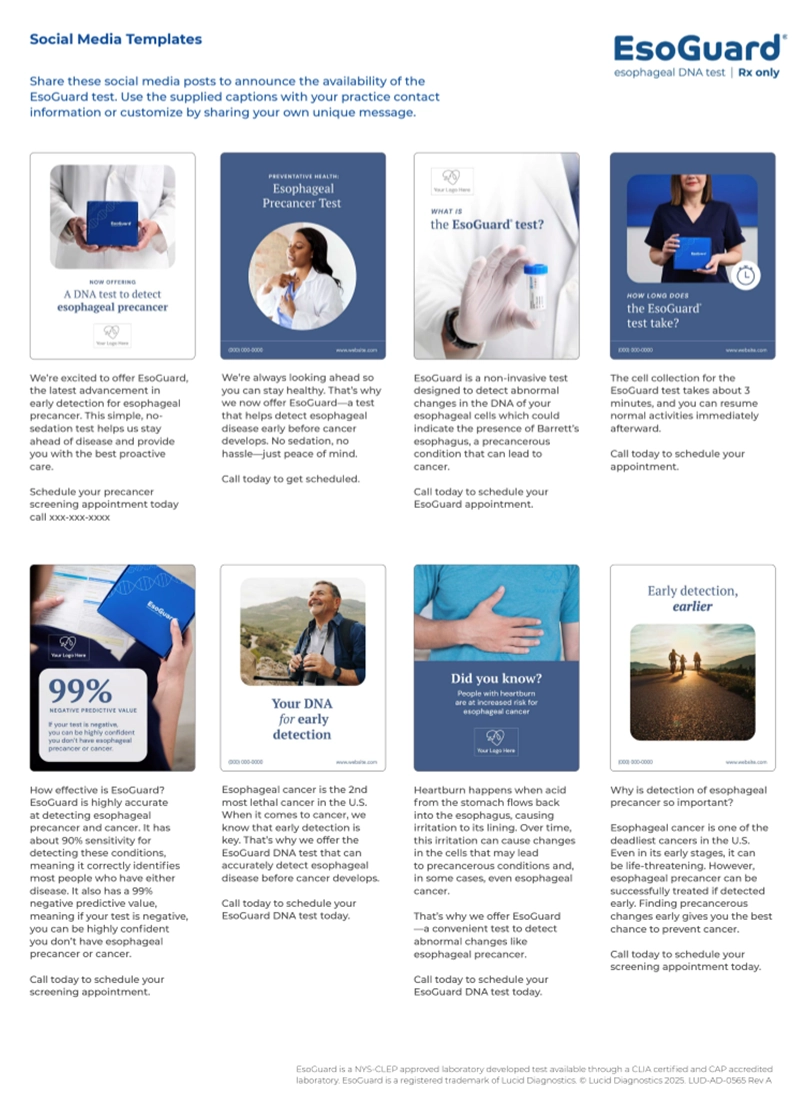ESOGUARD From Lucid Diagnostics
EsoGuard is a non-invasive test designed to detect abnormal changes in the DNA of your esophageal cells, which could indicate the presence of Barrett’s esophagus – a precancerous condition that can lead to esophageal adenocarcinoma (cancer).
How does EsoGuard work?
EsoGuard analyzes DNA from esophageal cells collected non-invasively. It looks for specific genetic markers associated with Barrett’s esophagus (esophageal precancer) and esophageal adenocarcinoma (cancer).
Who is the EsoGuard test for?
Adults who are at increased risk for esophageal precancer and cancer are eligible to undergo EsoGuard testing. These are individuals with chronic acid reflux (GERD) or heartburn, those over the age of 50, of white race, men, smokers, and people with obesity, or those with a family history of esophageal precancer or cancer.
How effective is EsoGuard?
EsoGuard is highly accurate at detecting esophageal precancer and cancer. It has about 90% sensitivity for detecting these conditions, meaning it correctly identifies most people who have either disease. It also has a 99% negative predictive value, meaning if your test is negative, you can be highly confident you don’t have esophageal precancer or cancer.
EsoGuard Test Facts :
- For established patients only $1995
- No Insurance Billing
- No SuperBills
TESTING PROCESS
How do I get EsoGuard?
You can request EsoGuard through your healthcare provider.
How do I prep for the EsoGuard test?
Do not eat or drink 2 hours prior to your esophageal cell collection procedure.
How is the test performed?
You swallow a tethered balloon capsule about the size of a vitamin tablet, which inflates to gently collect cells from the lower esophagus. It’s quick, non-invasive, and typically done in a doctor’s office. The cells are then sent to the Lucid lab for analysis.
How long does the test take?
The cell collection takes about 3 minutes, and you can resume normal activities immediately afterward.
ESOGUARD RESULTS
When do I get my results?
Test results, either positive or negative, are typically available within 2-3 weeks after your cell collection.
Where do I access my test results?
Test results are sent to the healthcare provider who ordered your test. Your provider will discuss your results with you. To request a copy of your results, please email
What does a positive result mean?
A positive test result means DNA changes were detected in your cells, but it does not necessarily mean you have cancer. Further evaluation is needed. Talk to your healthcare provider about getting an upper endoscopy with a biopsy—this is the only way to confirm the diagnosis and determine the exact stage of any disease.
What does a negative result mean?
A negative result means the test did not detect the DNA changes in your cells that are associated with esophageal precancer or cancer. The likelihood of having disease is therefore very low. A negative result not rule out precancer or cancer with complete certainty.
Your doctor will decide if any further testing is needed based on your overall health and symptoms.
HEARTBURN AND CANCER
Why are people with heartburn at increased risk for esophageal cancer?
Heartburn happens when acid from the stomach flows back into the esophagus (the food tube), causing irritation to its lining. Over time, this irritation can cause changes in the cells that may lead to precancerous conditions and, in some cases, even esophageal cancer.
Do heartburn medications eliminate the risk of cancer?
No, taking antacids or other acid suppressing medications like proton pump inhibitors (PPIs) may improve symptoms, but they don’t eliminate the risk of developing disease. Even when reflux symptoms are well controlled, there is still a risk of developing esophageal precancer or cancer.
Why is detection of esophageal precancer so important?
Esophageal cancer is one of the deadliest cancers in the U.S., with less than 1 in 5 people surviving five years after diagnosis. Even in its early stages, it can be life-threatening. However, esophageal precancer can be successfully treated if identified promptly. Finding precancerous changes early, and managing them appropriately, gives patients the best chance to prevent cancer.

